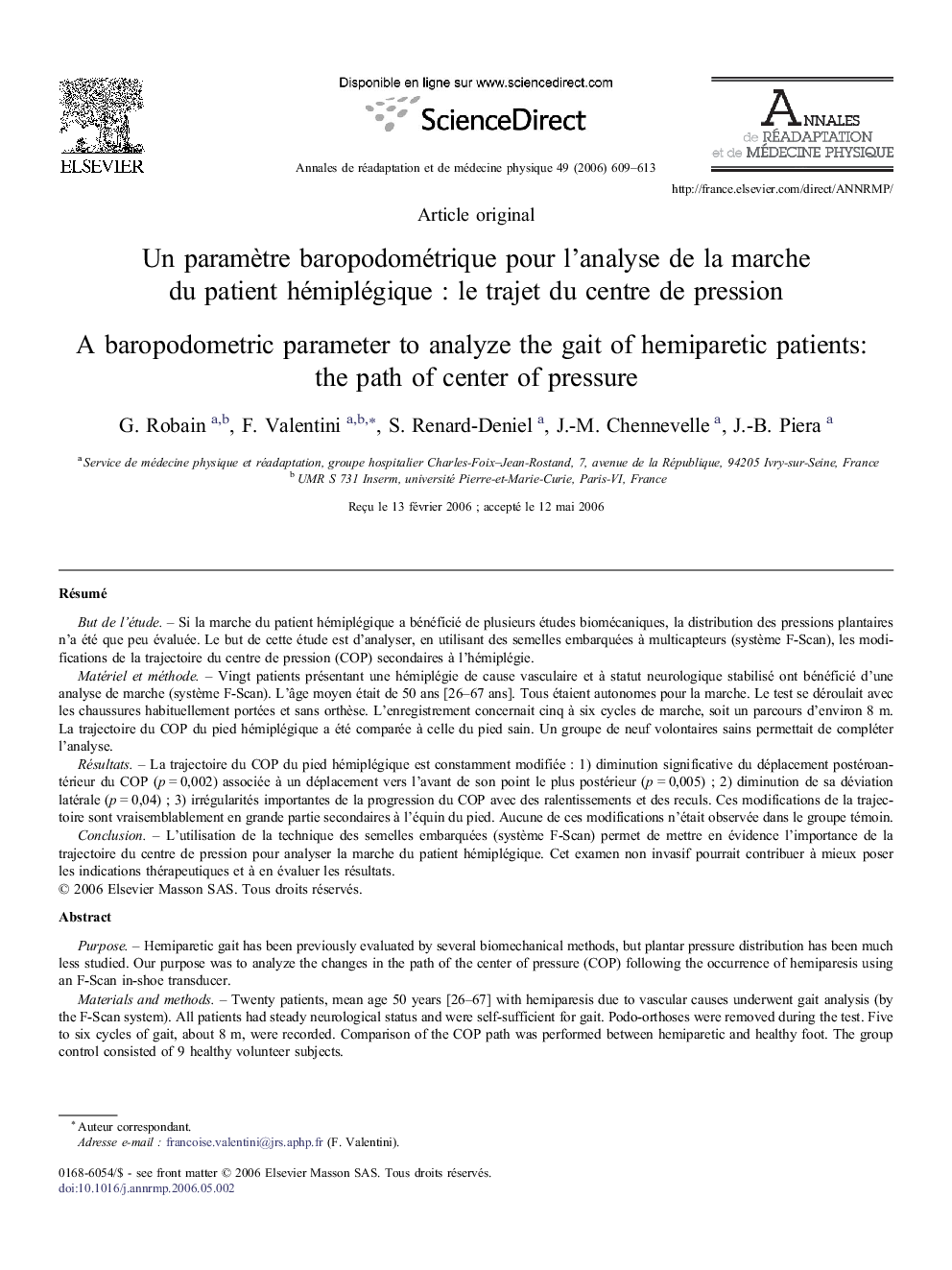| Article ID | Journal | Published Year | Pages | File Type |
|---|---|---|---|---|
| 4040386 | Annales de Réadaptation et de Médecine Physique | 2006 | 5 Pages |
RésuméBut de l'étudeSi la marche du patient hémiplégique a bénéficié de plusieurs études biomécaniques, la distribution des pressions plantaires n'a été que peu évaluée. Le but de cette étude est d'analyser, en utilisant des semelles embarquées à multicapteurs (système F-Scan), les modifications de la trajectoire du centre de pression (COP) secondaires à l'hémiplégie.Matériel et méthodeVingt patients présentant une hémiplégie de cause vasculaire et à statut neurologique stabilisé ont bénéficié d'une analyse de marche (système F-Scan). L'âge moyen était de 50 ans [26–67 ans]. Tous étaient autonomes pour la marche. Le test se déroulait avec les chaussures habituellement portées et sans orthèse. L'enregistrement concernait cinq à six cycles de marche, soit un parcours d'environ 8 m. La trajectoire du COP du pied hémiplégique a été comparée à celle du pied sain. Un groupe de neuf volontaires sains permettait de compléter l'analyse.RésultatsLa trajectoire du COP du pied hémiplégique est constamment modifiée : 1) diminution significative du déplacement postéroantérieur du COP (p = 0,002) associée à un déplacement vers l'avant de son point le plus postérieur (p = 0,005) ; 2) diminution de sa déviation latérale (p = 0,04) ; 3) irrégularités importantes de la progression du COP avec des ralentissements et des reculs. Ces modifications de la trajectoire sont vraisemblablement en grande partie secondaires à l'équin du pied. Aucune de ces modifications n'était observée dans le groupe témoin.ConclusionL'utilisation de la technique des semelles embarquées (système F-Scan) permet de mettre en évidence l'importance de la trajectoire du centre de pression pour analyser la marche du patient hémiplégique. Cet examen non invasif pourrait contribuer à mieux poser les indications thérapeutiques et à en évaluer les résultats.
PurposeHemiparetic gait has been previously evaluated by several biomechanical methods, but plantar pressure distribution has been much less studied. Our purpose was to analyze the changes in the path of the center of pressure (COP) following the occurrence of hemiparesis using an F-Scan in-shoe transducer.Materials and methodsTwenty patients, mean age 50 years [26–67] with hemiparesis due to vascular causes underwent gait analysis (by the F-Scan system). All patients had steady neurological status and were self-sufficient for gait. Podo-orthoses were removed during the test. Five to six cycles of gait, about 8 m, were recorded. Comparison of the COP path was performed between hemiparetic and healthy foot. The group control consisted of 9 healthy volunteer subjects.ResultsDifferences in the COP path were found in the hemiparetic foot of patients: a significant decrease for the anteroposterior displacement (P = 0.002) and the lateral displacement (P = 0.04) and a significant anterior displacement of the more posterior contact COP (P = 0.005). The “gait line” was irregular, with slowing down going forward and, for some, going back. These results are likely consistent with the equine of the foot. No change was observed in the control group.ConclusionThe use of an F-Scan in the shoe transducer allows for revealing the importance of the COP path in analyzing hemiparetic gait; this noninvasive investigation would be helpful for evaluating the best therapy to propose to and to follow-up patients with hemiparesis.
